|
At the end of 2003,* an estimated 1,039,000 to 1,185,000
persons in the United States were living with HIV/AIDS [1].
In 2006, 35,314 new cases of HIV/AIDS in adults, adolescents,
and children were diagnosed in the 33 states with long-term,
confidential name-based HIV reporting [2].
CDC has developed a new and innovative
system designed to estimate the number of
new HIV infections (or incidence) for the
United States in a given year.
Using this new technology, CDC estimates
that 56,300 new HIV infections occurred in
the United States in 2006. [3]
By Sex
In 2006, almost three quarters of HIV/AIDS diagnoses among
adolescents and adults were for males.
Sex of adults and adolescents with HIV/AIDS
diagnosed during 2006
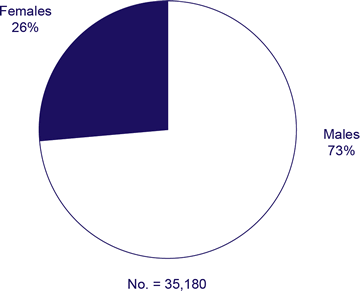
Based on data from 33 states with long-term, confidential name-based HIV reporting.
By Transmission Category
In 2006, the largest estimated proportion of HIV/AIDS
diagnoses among adults and adolescents were for men who
have sex with men (MSM), followed by persons infected
through high-risk heterosexual contact.
Transmission categories of adults and adolescents
with HIV/AIDS diagnosed during 2006
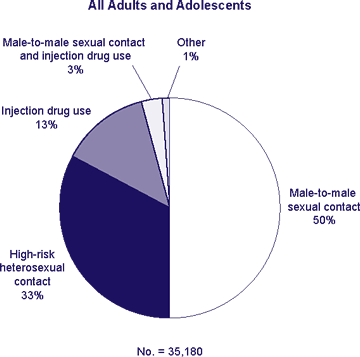
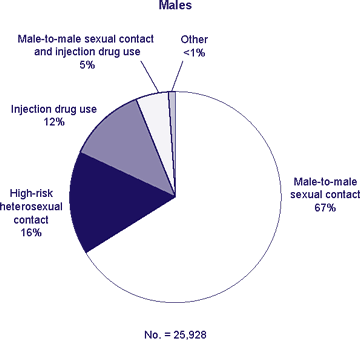
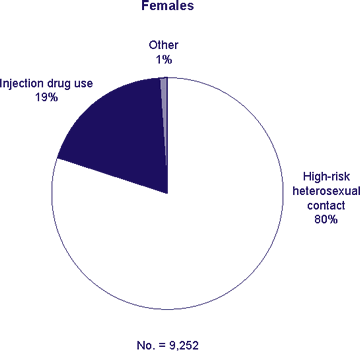
Based on data from 33 states with long-term, confidential name-based HIV reporting.
*The most recent year(s) for which these data are available.
By Race/Ethnicity
Although blacks, or African Americans,
made up only 13% of the population in the
33 states, they accounted for almost half
of the estimated number of HIV/AIDS
diagnoses made during 2006.
Race/ethnicity of persons (including children) with
HIV/AIDS diagnosed
during 2006
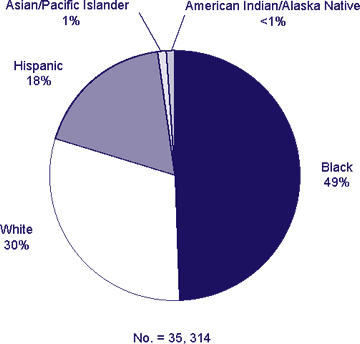
Based on data from 33 states with long-term, confidential name-based HIV reporting.
By Age
In 2006, persons aged 25–34 and persons
aged 35–44 accounted for the largest
proportions of newly diagnosed HIV/AIDS cases.
Age of persons with HIV/AIDS
diagnosed during 2006
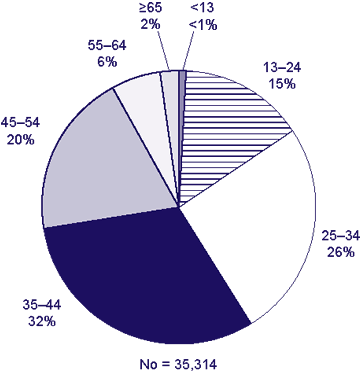
Based on data from 33
states with long-term, confidential
name-based HIV reporting.
Trends in AIDS Diagnoses and Deaths
During the mid-to-late 1990s, advances in HIV treatments slowed the progression of
HIV infection to AIDS and led to dramatic decreases in deaths among persons with AIDS
living in the 50 states and the District of Columbia. In general, the trend in the estimated
numbers of AIDS cases and deaths remained stable from 2002 through 2005. Estimates
for 2006 suggest that the number of AIDS cases remained stable and that the number of
deaths decreased; however, it is too early to determine whether this trend will hold. Better
treatments have also led to an increase in the number of persons who are living with AIDS.
Estimated numbers of AIDS diagnoses, deaths, and persons living with AIDS, 2002–2006
|
| |
 |
2002 |
 |
2003 |
 |
2004 |
 |
2005 |
 |
2006 |
 |
Cumulative
(1981-2006) |
|
| AIDS diagnoses |
 |
38,132 |
 |
38,538 |
 |
37,726 |
 |
36,552 |
 |
36,828 |
 |
982,498 |
|
 |
| Deaths of persons with AIDS |
 |
16,948 |
 |
16,690 |
 |
16,395 |
 |
16,268 |
 |
14,016 |
 |
545,805 |
|
 |
| Persons living with AIDS |
 |
350,419 |
 |
372,267 |
 |
393,598 |
 |
413,882 |
 |
436,693 |
 |
NA |
|
NA, not applicable (the values
given for each year are cumulative).
Based on data for the 50 states and the District of Columbia. |
REFERENCES
- Glynn M, et al. Estimated HIV
prevalence in the United States at the
end of 2003. National HIV Prevention
Conference; June 12–15, 2005; Atlanta.
Abstract T1-B1101.
- CDC.
HIV/AIDS Surveillance Report,
2006. Vol. 18. Atlanta: US Department
of Health and Human Services, CDC;
2008.
- Hall HI, Ruiguang S, Rhodes P, et al. Estimation of HIV incidence in the United States.
JAMA. 2008;300:520-529.
|